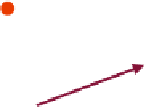Environmental Engineering Reference
In-Depth Information
CO
2
, N
2
P
CO
2
Figure 7.6.7
Selectivity versus permeation for a porous material
The effect of changes in the chemistry on the selectivity
α
and permeation. Each dot
represents a model membrane with a different pore structure (larger cavities, smaller
windows, etc.). The arrows indicate how the performance of the materials would change
if we change the interactions with the walls.
which we could make the same chemical modifi cations. The results of this
simple analysis are shown in
Figure 7.6.7
. Our model predicts a very dif-
ferent Robeson plot than those found for polymers in the literature (see, for
example
Figure 7.5.2
). Our simple analysis suggests that nanoporous
materials do not exhibit the Robeson upper bound.
“Experimental” nanoporous membranes
In the previous section, we developed a simple theory that predicts that
nanoporous materials will not exhibit a Robeson upper bound. Robeson's
observation of that upper bound was based on the analysis of a large
number of different polymer membranes. The synthesis of membranes
comprised of nanoporous materials has only been developed very recently.
For example, Tsapatsis [7.17] and his co-workers have been able to syn-
thesize membranes using zeolites. How the pore topology of these zeolites
infl uences the performance of the membrane is an interesting question. As
the number of structures is so small, we have to rely on molecular simula-
tions to predict the permeability and selectivity. In Chapter 6, we showed


























Search WWH ::

Custom Search